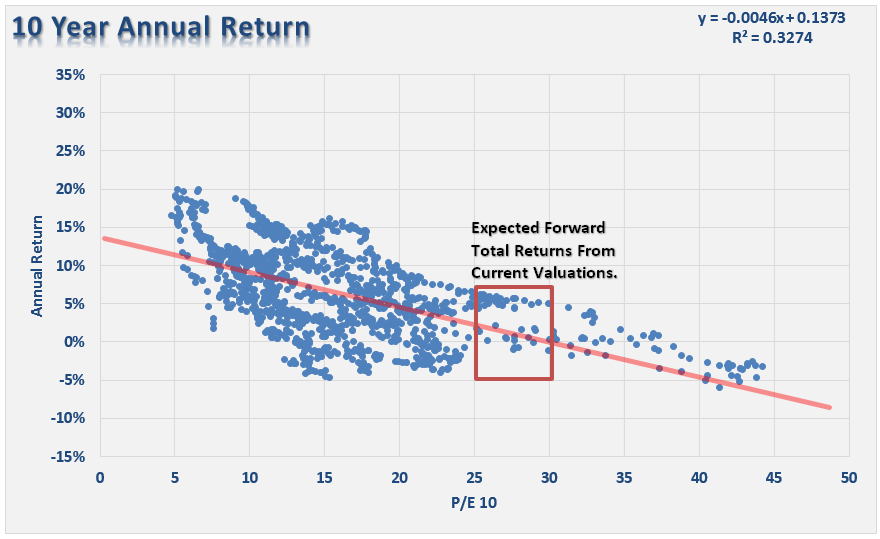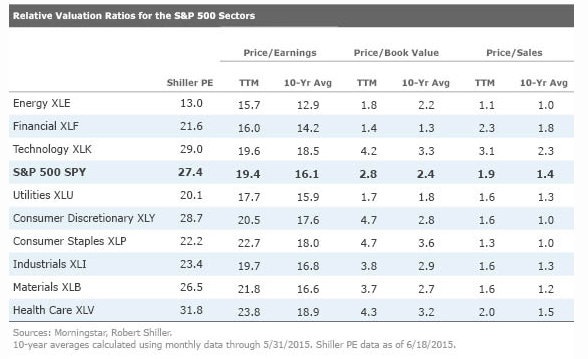You Can't Handle The Truth
John Coumarianos recently wrote an opinion piece for MarketWatch stating:
"...if you think low interest rates necessitate high stock prices, that wasn't the case in the 1940s when interest rates were low and stock prices were below their long-term average relative to past earnings.
True, we don't know what the market will do over the short term, but we know with some reasonable probability what it might return over the longer run. The Shiller PE and Tobin's Q provide some significant probability beyond zero with regard to future 10-year returns.
We don't have zero or no knowledge. We don't have certainty either, but it's probable that stocks will deliver anemic returns over the next decade given where Shiller and Q are currently. Incidentally, stocks have provided anemic returns for the past 15 years (less than 5% annualized for the S&P 500 SPX, +0.69% including dividends) with the starting Shiller PE for the period above 40. So talk that the Shiller PE has lost its mojo isn't accurate. The market delivered significantly subpar returns for the following 10- and 15-year periods starting from the highest Shiller PE on record."
I discussed the importance of valuations and forward-return expectations in the past but John's commentary is very important because it highlights a huge disconnect between what individual individuals THINK and how they ACT. Specifically, individuals believe they are truly "long-term" investors and that they will make investments for very long periods of times (10 years or more.)
However, as shown by repeated studies, that belief is confounded by the fact that individuals react to short-term market volatility and other inputs which leads to emotional decision making. Of course, the media/press/blog community is primarily to blame for these actions by focusing a spotlight on each data point within the financial markets rather than helping investors focus on the "long game."
One of the more useless discussions as of late has been on the irrelevance of high valuations as it relates to market returns of the next 12 months. To wit:
""The so-called CAPE, popularized by Professor Shiller of Yale is extended but unfortunately has no ability to predict stock price outcomes a year later," Citi's Tobias Levkovich said on Friday. 'Yet, that does not seem to confound the bears, which we find both intriguing and revealing about motive rather than study.'"
The problem is what I have addressed in the past as a "duration mismatch." Shiller's CAPE ratio is not about what happens in the next year but rather what returns investors should expect over the next 10 or 20 years. After all, we are saving and investing for our retirement, right?
The following two charts show the TOTAL (dividend reinvested) REAL (inflation adjusted) forward returns from every level of CAPE since 1900. I have noted with the red box the current range of CAPE.
The good news is that forward returns over the next decade or two have IMPROVED from the low levels witnessed at the turn of the century. The bad news is that forward returns are likely to be PRIMARILY a function of inflation and dividends more than capital appreciation. Unfortunately, most investors will do far worse.
Job Growth In 16-54 Group Still Non-Existent
In one of the most over-hyped and primarily useless economic data points thrown at investors every month is the employment report. Why there is such a focus on this particular report is beyond me. However, there are several points of interest/concern with the most recent report.
First, the employment for June was not only weaker than estimated but previous two months were also revised lower by 60,000 jobs in total.
Secondly, part-time jobs soared by 161,000 while full-time jobs collapsed by nearly 350,000. However, even worse was the addition of 640,000 individuals that are no longer counted as part of the work force. That led to the decline in the unemployment rate to just 5.3%. (Think about that for a moment. Almost 94 million individuals sitting outside the labor force and the BLS suggests that 94.7% of the population is employed.)
Lastly, the most important aspect of the employment report is the number of individuals between the ages of 16-54 that are employed as it relates to the entire population of that age group. The reason for concern is this age group is primarily responsible for working, buying cars, houses, iPhones and paying into the welfare support system. The problem, as shown in the chart below, is that the employment-to-population ratio for this group is not improving.
In other words, while the media gets overly excited about monthly job growth, the reality is that job growth has been little more than just a function of overall population growth. This isn't something the fosters long-term economic expansions that generate higher levels of prosperity.
Sector Valuations
John Gabriel recently penned a piece for Morningstar discussing valuations across sectors saying:
"Metrics like price/earnings ratios, or P/E, often contain a lot of "noise." By now we have probably all heard of those infamous special one-time noncash charges that can wreak havoc on earnings statements. But management also has several levers it can play with to "massage" the income statement. For example, the waters can be easily muddied by adjustments to the tax rate or an asset's depreciation schedule. Because earnings can be easily manipulated, many investors prefer using a price/sales ratio. But there are also drawbacks with P/S--namely, it tells you nothing about profitability."
This is all very true in the short-term. However, as noted above on overall market valuations, valuations above long-term averages precede lower long-term returns. As shown in John's table below, with the exception of Energy, due to the recent plunge in oil and stock prices, every single sector is trading above, or well above, their 10-year average.
This is particularly the case with historically more "defensive" sectors such as Healthcare, Materials, Staples and Industrials, which would be the beneficiaries of sector rotation during a market correction.
The potential problem for investors is that due to the "yield chase," which was fostered by Central Bank interventions, there is a real danger that "dividend investors" may suffer a much bigger correction in the future than has been seen historically as valuations mean revert.
Valuations, as always, should not be used as a market-timing device. However, what valuations can tell us, particularly at elevated levels, is that future returns are not only going to be disappointing on the average, but the eventual mean reversion process will be more destructive than most investors realize.
Just something to think about.




